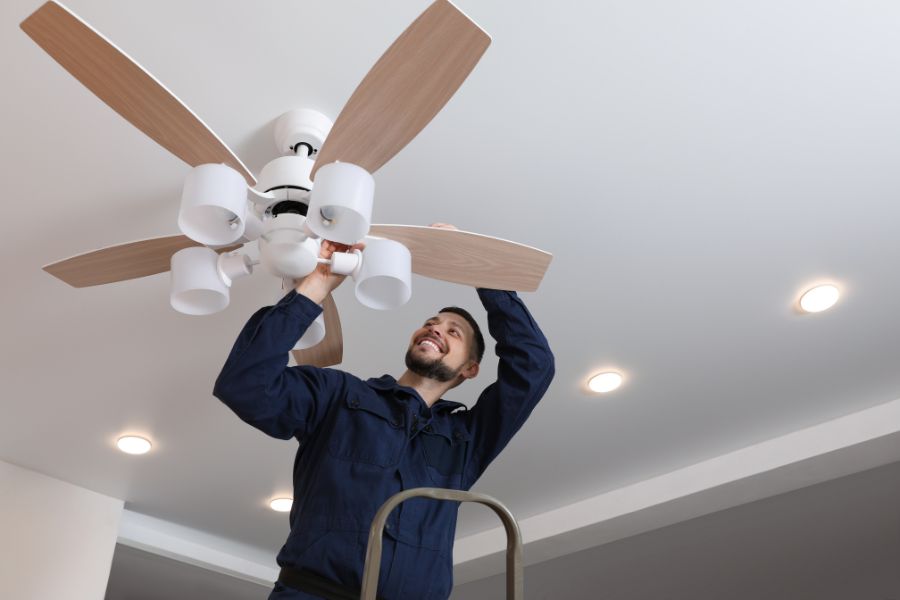
Why Ceiling Fans Are Essential for Modern Homes
Ceiling fans have long been a practical addition to homes, providing year-round comfort with improved air circulation and energy efficiency. In modern homes, ceiling fans are not just functional but also serve as design statements that can complement contemporary, rustic, industrial, or traditional aesthetics. With the rising cost of electricity and increasing awareness about energy conservation, many homeowners are turning to ceiling fan installation as a cost-effective solution.
In this comprehensive guide, we’ll cover everything you need to know about ceiling fan installation, from the benefits and types of ceiling fans to step-by-step installation procedures and why hiring a professional is often the best choice.
The Benefits of Ceiling Fan Installation
1. Energy Efficiency and Cost Savings
Ceiling fans help reduce energy consumption by assisting heating and cooling systems. In summer, they create a wind-chill effect that makes a room feel cooler, reducing the need for air conditioning. In winter, reversing the fan direction circulates warm air trapped near the ceiling, minimizing heating costs. According to the U.S. Department of Energy, using ceiling fans can help save up to 15% on energy bills.
2. Improved Air Circulation
Good air circulation is essential for maintaining indoor air quality and comfort. Ceiling fans distribute air evenly, preventing hot or cold spots and ensuring that fresh air reaches all corners of the room.
3. Aesthetic Appeal
Modern ceiling fans come in various designs, materials, and finishes. Whether you’re aiming for a minimalist look or a bold statement piece, there’s a ceiling fan to match your decor.
4. Environmental Impact
Using ceiling fans to reduce HVAC dependence leads to lower carbon emissions, contributing to environmental sustainability.
Choosing the Right Ceiling Fan for Your Home
1. Blade Size and Number
Larger blades move more air but require more space. For rooms larger than 400 sq. ft., choose fans with a blade span of 52 inches or more.
2. Motor Quality
High-quality motors ensure quiet, efficient performance. DC motors are more energy-efficient and quieter than traditional AC motors.
3. Additional Features
- Remote Controls: Convenient for rooms with high ceilings.
- Smart Home Integration: Control your fan via smartphone apps.
- Lighting Options: Fans with integrated lights provide dual functionality.
Step-by-Step Guide to Ceiling Fan Installation
1. Preparation and Safety Precautions
- Turn off the power at the circuit breaker.
- Gather tools: screwdriver, voltage tester, wire stripper, and a ladder.
- Ensure the electrical box is rated for ceiling fans.
2. Mounting the Ceiling Bracket
- Remove the existing light fixture.
- Attach the fan’s mounting bracket to the electrical box using the provided screws.
3. Wiring the Ceiling Fan
- Connect the fan wires to the corresponding ceiling wires (black to black, white to white, and green to ground).
- Secure connections with wire nuts and electrical tape.
4. Attaching Fan Components
- Secure the fan motor to the mounting bracket.
- Attach the fan blades and ensure they’re balanced.
5. Testing the Fan
- Restore power and test the fan’s functionality.
- Check all speed settings and ensure the fan runs smoothly without wobbling.
Common Challenges in Ceiling Fan Installation
1. Wobbling Fan
Occurs when blades are uneven or improperly balanced. Use a balancing kit to resolve this issue.
2. Electrical Problems
Improper wiring can cause the fan to malfunction. Always double-check connections and consult an electrician if needed.
3. Noise Issues
Loose components or low-quality motors can cause noise. Regular maintenance can help keep the fan quiet.
Professional Ceiling Fan Installation: Why It Matters
Hiring a licensed electrician ensures safe, code-compliant installation. Professionals can also recommend the best fan models and placement for optimal performance.
Advantages of Professional Installation:
- Safety: Reduces the risk of electrical hazards.
- Efficiency: Faster, more accurate installation.
- Warranty Protection: Many warranties require professional installation.
Maintenance Tips for Ceiling Fans
- Clean fan blades every few months.
- Check and tighten screws and connections annually.
- Lubricate the motor if required by the manufacturer.
Ceiling fans are versatile, energy-efficient, and stylish additions to any home. While DIY installation is possible, professional services guarantee safety, efficiency, and long-term reliability. Invest in ceiling fan installation to improve comfort, save on energy bills, and elevate your home’s interior design.
FAQs
1. How long does it take to install a ceiling fan?
The time it takes to install a ceiling fan can vary depending on several factors, such as whether there is existing wiring, the type of ceiling fan being installed, and the location. On average, a professional installation takes between 1 to 2 hours if the wiring and support box are already in place. If new wiring or support structures are needed, the process can take up to 4 hours or more. DIY installations may take longer due to the learning curve involved.
2. Can I install a ceiling fan where a light fixture is?
Yes, you can install a ceiling fan where a light fixture is located, but there are some important considerations. The existing electrical box must be rated to support the weight and movement of a ceiling fan, as standard light fixture boxes are not designed to handle the dynamic load of a fan. If the box is unsuitable, an electrician can replace it with a fan-rated box. Additionally, the wiring may need to be adjusted to accommodate the fan’s motor and control features.
3. How often should I clean my ceiling fan?
Ceiling fans should be cleaned at least every 2 to 3 months to maintain optimal performance and indoor air quality. Dust buildup on the blades can cause wobbling and reduce the fan’s efficiency. For fans in kitchens or bathrooms, more frequent cleaning may be necessary due to grease or moisture accumulation. Use a microfiber cloth or a vacuum cleaner with a brush attachment to clean the blades gently.
4. What is the best ceiling fan size for my room?
The ideal ceiling fan size depends on the room’s dimensions. For rooms up to 75 sq. ft., a fan with a blade span of 29-36 inches is sufficient. For medium-sized rooms (144-225 sq. ft.), choose a 42-52 inch fan. Larger rooms (over 400 sq. ft.) may require fans with a 60-inch blade span or the installation of multiple fans for even air distribution.
5. Can I install a ceiling fan on a sloped ceiling?
Yes, ceiling fans can be installed on sloped or vaulted ceilings using an angled mounting kit. The angle of the slope determines the type of downrod and bracket required. It’s essential to ensure the fan blades have sufficient clearance from the ceiling to avoid contact and maintain efficient airflow. Professional installers can help select the correct hardware for sloped ceilings.







